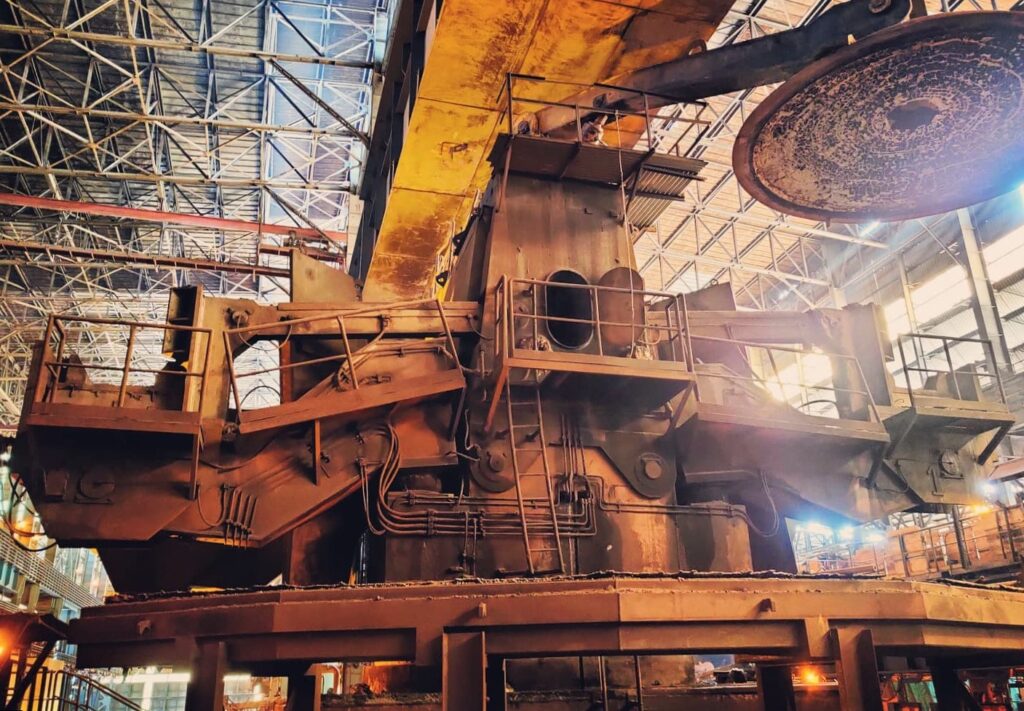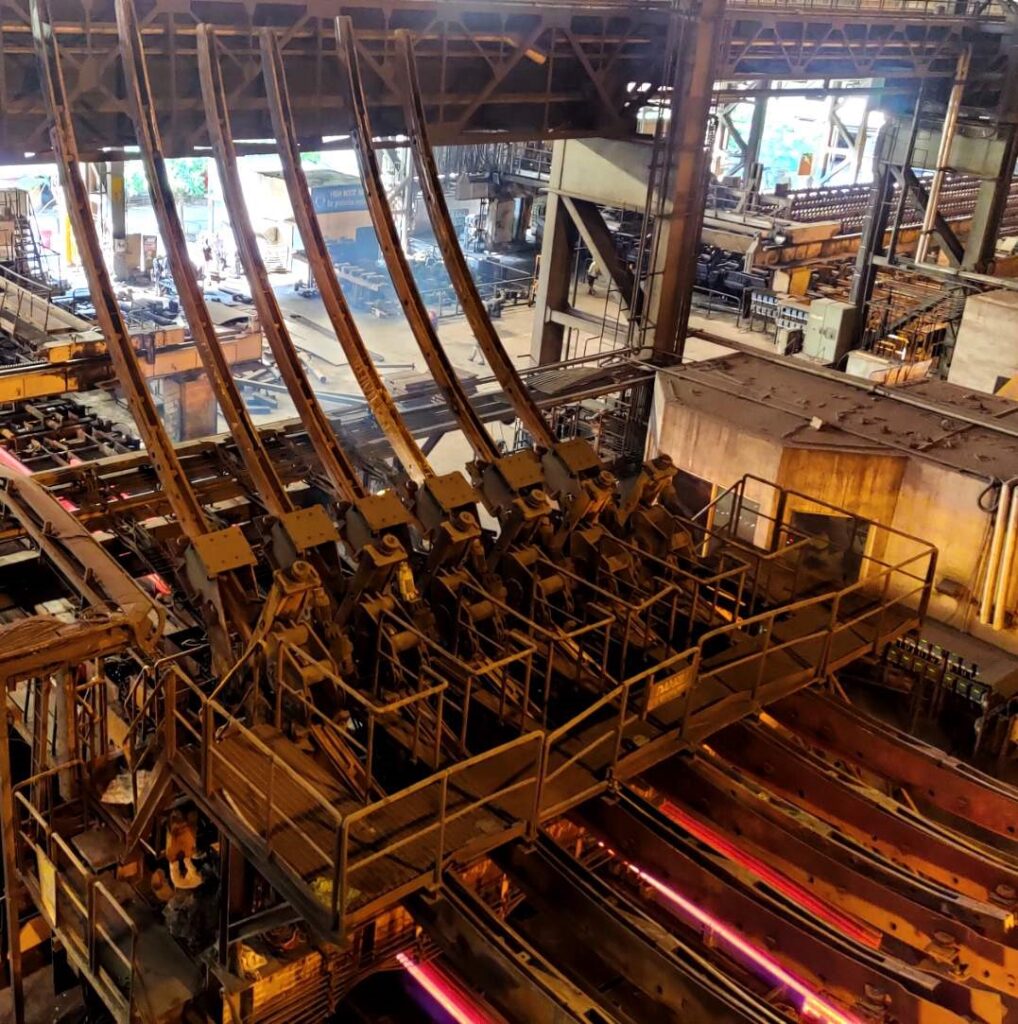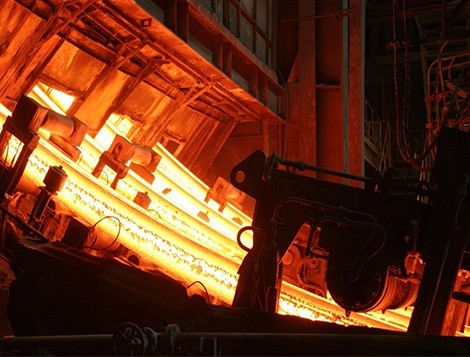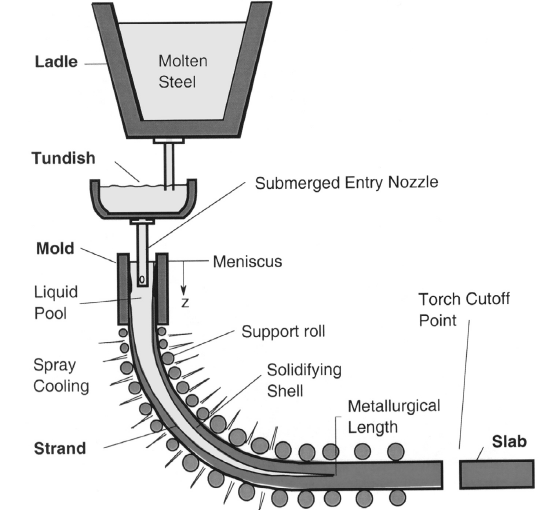The basic principles for the continuous casting process are based on teeming the liquid steel vertically into a water-cooled copper mould which is open at the bottom. Heat transfer takes place from the water-cooled copper plate which solidifies the liquid steel and a solid skin/shell is formed. The skin/shell thickness increases down the length of the copper mould. Two fundamental principles which are required to avoid sticking of the solidifying skin to the copper mould are:
1. The mould is reciprocated sinusoidally at a frequency that provides a negative strip i.e the mould moves downward faster than the solidifying strand for a part of the oscillating cycle.
2. A lubricant is provided which will act as an interface between the solidifying shell and the mould copper plate. Prior to around 1965 rapeseed oil had been used almost exclusively as the lubricant and is still used for the smaller sizes where a refractory submerged entry nozzle cannot be used. On most machines, a synthetic casting powder is used on the top of the metal in the mould. The powder in contact with the liquid steel melts to form a slag which infiltrates into the gap between the steel and the copper at the meniscus to provide lubrication.
After the strand exit from the mould the shell is sufficiently thick and attains sufficient strength so as to contain the liquid steel and bear the ferrostatic pressure and thermal stresses. It is then further cooled by water sprays. The reason why the copper mould is not continued for further solidification is that cooling shrinkage takes place and this contraction results in the formation of an air gap between the copper wall and the outer shell making the mould less efficient as far as heat transfer is concerned. Thus direct spraying from the high-pressure nozzles is found to be more effective. However, the thin shell cannot withstand the pressure due to the presence of the liquid metal inside the shell and thus if unconstrained will cause bulging of the outer shell. Thus mechanical support or rollers is to be provided for support of the solidifying shell. The design or the diameter of the rollers is selected based on the ferrostatic forces applied on it and the quality requirements.
During normal/steady-state casting the strand is extracted from the mould at a constant speed with the help of the extraction rolls.
The turret rotates quickly to bring a full ladle of steel to its casting position from the charging position so as to enable continuity of casting.
Process:
The liquid steel has teemed from the steelmaking metallurgical vessels onto the steel ladles and after proper secondary metallurgical treatment, the ladle is lifted by means of an EOT crane and placed onto a ladle car of the caster machine commonly known as the ladle turret. The steel then flows from the ladle into the tundish. The flow from the ladle is controlled by means of the sliding valve mechanism. The stream is further protected from reoxidation and heat loss by the use of a refractory tube known as the shroud. Due to the practice of operating more than one strand in parallel the steel is poured into the tundish. The main functions of which are to distribute the steel over the number of casting strands and to provide a more constant head to facilitate the control of pouring the liquid steel into the mould. The tundish design and the configuration depends on the number of strands and the distance apart from the strands. In slab casting, the number of strands rarely exceeds two and some machines only have a single strand. For bloom casting the number of strands can be from 2 to 8 depending on the ladle size, bloom size, and the required casting rate. When eight strands are used for billet casting only 1 tundish may be required because of the reduced centerline separation of the strands when compared to the casting of larger blooms.

To achieve higher utilization of the machine several ladles are often cast in sequence termed the sequence factor or the sequence ratio i.e the process continues while the empty ladle is replaced by the next full one and quick ladle exchanging is achieved by the use of ladle turret or by having two ladle cars. As a further effort to extend the sequence length the tundish is often replaced “on the fly” since the tundish and in particular, the submerged nozzle or stopper can limit the number of heats.
Apart from the smallest section sizes (billets below 130mm square) the liquid steel stream between the tundish and mold is again protected from the atmosphere by a refractory tube. Open pouring is employed for the casting of smaller cross-sections especially for billets but the stream is normally protected by gas shrouding.
After the strand has traveled few meters down the length of the machine, it completely solidifies and this position is determined by several factors such as casting speed, cooling parameters, and the section crosssection. This length from the meniscus to the position where the strand is completely solid is known as the metallurgical length.
In order to withdraw a fully solidified slab in a horizontal position the slab is cast on curvature and the radius depends on factors such as product crossection and the quality requirements.
The strand is straightened by the use of rollers at the position where it becomes horizontal and is withdrawn from the machine by power-driven pinch rolls. In billet casting, this may not only consist of one or two pairs of driven rolls but in slab caster, the withdrawal unit may consist of many driven rolls and sometimes arranged in segments. As the strand exits the machine after crossing the straightening section, an oxy-cutting torch that travels at the same speed as the strand cuts the product transversely. The torch reverses back to its home position after the completion of the cutting process. The cut product is then accelerated down a roller table to the discharge section where it transferred with the help of a liftable transfer car onto the walking beam cooling bed which is of turn over type. Here the strand is uniformly cooled and further despatched to the bloom storage yard for stacking. However, modern caster utilizes the heat content of the product by transferring the product directly to the mills after cutting for further processing. This, in turn, leads to savings of energy and capital cost.
The start-up of the casting process requires a dummy bar head whose dimensions are slightly less compared to that of the mould. The dummy bar is inserted and is driven into the bottom of the mould from the bottom of the machine by the use of linked and connected units known as the dummy bar chain. The dummy bar chain is driven by the “withdrawal” rolls and the head is placed in a position that extends slightly to the bottom of the mould. Few machines have the privilege of insertion of dummy bar from the top of the mould. The use of the top-fed dummy bar has been employed in order to reduce the restranding time between the sequences. This enables the dummy bar chain to be guided into the strand through the mold while the previously solidified strand is still being run out. The dummy bar can be generic chain type or rigid type. Solid/rigid type dummy bar has the provision to be inserted from the bottom. Packing is then inserted into the small gaps between the plate and the dummy bar head with the help of a ceramic rope or sheets. The dummy bar head is shaped in a claw-like fashion so that when the liquid steel enters the mould it solidified around the claw. Modern machines have the provisions for head sealing arrangements which are directly attached to the dummy bar head. This attachment has a typical structure either like a Christmass tree or criss-cross plate with the sealant at the bottom. This structure ensures proper anchoring of the initial solidified metal during the start of the cast process. The flow from the tundish is regulated either by a slide gate or stopper rod mechanism. After the mould is filled, oscillation starts and the strand is withdrawn and simultaneously the movement of the dummy bar commences. When the dummy bar head and the lending end of the strand exit the machine, the head is disconnected and the dummy bar chain is withdrawn separately and parked in ambush.

It should be appreciated that the solidifying shell as it leaves the mould is relatively weak and any undue friction in the mould or any other factors which influence the growth of the shell thickness due to uneven cooling can lead to a breakout. Breakouts are undesirable and expensive because these can lead to an interruption of the sequence, loss of productivity, and an increase in the casting time duration. Moreover, the machine is recovered from the results of the spilled metal resulting from breakouts often by changing the mold and the top secondary cooling zone. Rupture of the initially formed solidifying steel around the claw of the dummy bar head can also result during the start of the cast process. Modern casters are equipped with sensors and breakout detection system to avoid breakouts and are also designed in a manner which allows for rapid recovery time.
The continuous caster in a steel plant must be suitable for the furnace capacity and the heat size on the one hand and existing or planned downstream production facilities on the other. Sometimes existing buildings, cranes, ground conditions, etc also have to be taken into account.
The types of continuous caster in operation are as follows:
1. Simple vertical caster
a. With rotating strand
b. Without rotating strand
2. Casters with straight, vertical and inclined mould.
a. with bending and straightening of the solidified strand
b. with strand bending while the core is still liquid and the straightening once the core has solidified.
c. with bending and straightening of the strand where the core is still liquid
3. Casters with curved mould
a. with straightening of the solidified strand
b. with straightening of the strand where the core is still liquid
4. Horizontal caster
The bending and the straightening are carried out in one or several steps. In a bow-type caster, the position of the mould on the arc should preferably be selected such that the length of the strand periphery at the liquid level in the moulds is minimized. The term billet refers to the product’s crosssections where the side dimensions are less than or equal to 150 mm approx. Whereas the term bloom refers to crosssections where the side dimensions are greater than 150 mm, having a thickness to width ratio of 1:1.3. However, this categorization is made irrespective of the number of reheating stages in the subsequent production process. The term slabs are associated with crosssections with a thickness greater than 100 mm, having a thickness to width greater than 1:1.3. The present smallest billet cross sections cast under industrial production conditions is 80 x 80 mm, while the largest bloom crossection is 420 x 360 mm, and the largest slab width is 3100 mm.
Rounds strands and hexagonal/octagonal strands are classified as either billets or blooms depending on their diameter or width. In addition to these are hollow strands that provide the starting material for large seamless pipe and so-called “dog bones” or “beam blanks” which are used as the starting material for structural sections. These are also multipurpose casters on which the twin or triple casting method.
Nowadays continuous casters are built for virtually all killed unalloyed and alloyed steels. The caster design influences both operations and product quality. The type of caster selected determines its overall height, the requisite withdrawal, bending and straightening equipment, and also the runout facilities. The overall height has a direct effect on the amount of the ferrostatic pressure inside the strand and thus the requisite roll spacing and the roll loads. The overall height is the geometric height of the liquid head from the surface of the liquid metal in the mould to the tip of the liquid core. This, in turn, determines the ferrostatic pressure which is brought to bear on the strand shell and the support rolls.
In the case of large strand sizes, particularly the slab formats, the stress caused by the static pressure of the liquid steel inside the strand leads to bulging in the already solidified strand shell. It is therefore imperative to provide adequate support for the strand at least to the end of the liquid core.
Bulging in the strand shell between the support rolls must not be allowed to exceed the certain limit values as otherwise, cracks can occur inside the strand due to the shell being deformed as it passes through. Large degrees of bulging also result in high strand withdrawal forces being applied and can, therefore, cause surface cracking to occur. When designing casters it is, therefore, recommendable to specify the maximum strand bulging values that will safely prevent strand damage and to calculate from these values the maximum permissible support roll intervals. These values will however largely depend on the chemical composition of the steels being cast and must be determined on a case by case basis according to the product mix.
The overall heights of the continuous caster built in the last ten years have tended to be lie between 10 and 12m. But in the case of very thin slab crossection or for billet having crossections of 150 mm, there is a chance of having caster heights between 5 and 8 m. However, few exemptions include a few vertical casters for very large bloom crosssections (400 to 500 mm) and also the bow type casting machines for heavy slabs at Mannesmann and Sumitomo, which are having a caster height of approx. 5m.
Today the most common caster type has a curved mould. The strand leaves this curved mould in an arc without deformation of the thin shell, passes through the secondary cooling section again without being subjected to bending stresses, and is straightened to horizontal particularly in the case of slab casters – by a withdrawal and support section comprising a number of driven rolls. At low casting speeds, the straightening operation is applied where the strand’s core has already solidified. As the casting speed increases, so does the length of the liquid core. In the case of small casting radii, and thus small overall heights, the tip of the liquid core extends further into the horizontal section of the machine. In such cases, the strand is thus straightened with the core still in its liquid phase.
As the strand crossection decreases, the casting speed increases, and regular casting speeds up to 3.8 m/min are possible. However, slabs of a comparable thickness (eg-250 x 250 mm as compared with 250 x 380-1900 mm) are often cast at substantially higher speeds when compared to blooms of the same thickness. The reason for this is usually that the caster length is too short. Also, lack of strand guidance and support often means that steelmakers have to operate their bloom casters at low casting speeds.

The type of casters and its overall height leads to both operating advantages and disadvantages which influence the level of expenditure required to achieve the required product quality. As the overall height increases so does the investment expenditure not only for the caster but also, for example, for the building, cranes, foundations and requisite pump ratings. Operational costs are also adversely affected by, for example, additional power costs for the necessarily larger ladle lift and heavier machines for handling and supporting the strands.
Simple Vertical caster
Advantages:
No deformation through bending and straightening
No restriction of oxide float out
Disadvantages: Large overall height, high ferrostatic pressure at the core tip, high cost of molten steel handling facilities and strand support machinery, danger of large degrees of bulging between the rolls, casting speed usually limited by lack of available depth.
Bow type caster with straight moulds
Advantages:
Minimal hindrance of oxide float out provided the vertical section is sufficiently long
Disadvantages:
Early and considerable deformation of the strand shell, bending section without driven rolls, large overall height or large degree of straightening deformation, higher ferrostatic pressure than in the case of curved mould, double deformation.
Bow type caster with curved mould:
Advantages: Strand straightened only when shell is relatively thick, low overall height, low ferrostatic pressure, simple withdrawal and removal.
Disadvantages: Oxide float out hindered.
It is recommended that the casters with a straight mould must be provided with an approx. 2.5 to 3 m long vertical section. The approx. 30% higher ferrostatic pressure at the liquid core tip and early bending of the strand while its shell is relatively thin and its surface temperature still uneven can cause surface cracking, internal cracking and centerline segregation.
Bending the strand while its core is still in the liquid phase has its limitations: the thinner the strand shell, the greater is the degree of internal deformation. Bending sections with 10 or more bending points are therefore necessary in order to distribute the internal deformation and leave the strands unimpaired. Careful control and maintenance of the secondary cooling section in the area of the early strand deformation are particularly important to ensure a strand surface that is free of transverse cracks.
The higher the ferrostatic pressure in bow type casters with larger casting radii, and in bending and straightening casters with a vertical section, it has to be overcome by employing correspondingly sturdier and thus heavier machine components (rolls, apron, segments etc). Segregation filled internal cracks in the vicinity of the core, and centerline segregation depend in the part on the degree of bulging in the strand shell between the rolls and thus on the ferrostatic pressure. The pronounced bulging encountered in the heavy machine may, owing to necessarily small roll spacing, render segmented roll or if the steel grade allows, an additional secondary cooling system is necessary.
In the case of bow-type caster, an uneven distribution occurs because some of the inclusions become deposited on the solidification front of the inner ac of the strand shell. Larger radii and increasing strand thickness cause the inclusion line to be shifted towards the center, resulting in more favorable conditions for precipitation.
In the case of a caster with a straight mold bending deformation takes place at a relatively early stage in the solidification process and the thinner the strand shell, the higher the degree of deformation. Moreover, owing to the intensive cooling which takes place in this area, the resultant uneven temperature distribution in the strand has also to be taken into consideration. A decrease in the casting speed can be made to comply with the maximum permissible degree of deformation. In casters with curved mold, this deformation occurs later i.e when the shell is rather thicker.
Steels of varying composition often react quite differently to bending, straightening, and cooling. It must, therefore, be emphasized that a continuous casting machine has to be specifically designed to accommodate not only the prevalent heat size and the downstream processing facilities but also the steel grades to be cast.



